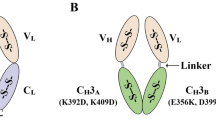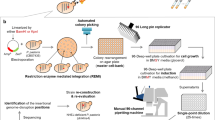Abstract
We have applied a Bacillus subtilis expression-secretion system to produce a functional antidigoxin SCA (single-chain antibody consisting of VL-linker-VH) and the individual variable domains of light (VL) and heavy (VH) chains. The secreted antidigoxin SCA can be affinity purified in one step by applying the culture supernatant directly to a ouabain-Sepharose column. N-terminal sequence determination indicated that the protein has the expected N-terminus with the signal peptide properly processed. Affinity and ligand specificity studies demonstrated that the engineered antidigoxin SCA has almost identical properties as those of the parental monoclonal antibody. The use of B. subtilis WB600, an engineered, six-extracellular protease-deficient strain, is vital for the production of antidigoxin SCA in high quality and quantity (5 mg/liter in a shake flask culture). All the secreted SCAs are biologically active. The ability to produce secreted SCAs by the B. subtilis expression system provides a simple and efficient means to analyze the binding properties of engineered antibodies generated through rational design or site-directed mutagenesis.
This is a preview of subscription content, access via your institution
Access options
Subscribe to this journal
Receive 12 print issues and online access
$209.00 per year
only $17.42 per issue
Buy this article
- Purchase on Springer Link
- Instant access to full article PDF
Prices may be subject to local taxes which are calculated during checkout
Similar content being viewed by others
References
Kulick, D.L. and Rahimtoola, S.H. 1991. Current role of digitalis therapy in patients with congestive heart failure. JAMA 265: 2995–2560.
Litovitz, T. and Veltri, J.C. 1987. 1986 annual report of the American Association of Poison Control Centers National Data Collection System. Am. J. Emerg. Med. 5: 405–445.
Aronson, J.K. 1983. Digitalis intoxication. Clin. Sci. 64: 253–258.
Antman, E.M. and Smith, T.W. 1985. Digitalis toxicity. Ann. Rev. Med. 36: 357–367.
Antman, E.M., Wenger, T.L., Butler, V.P. Jr., Haber, E. and Smith, T.W. 1990. Treatment of 150 cases of life-threatening digitalis intoxication with digoxin-specific Fab antibody fragments. Circulation 81: 1744–1752.
Mauskopf, J.A. and Wenger, T.L. 1991. Cost-effectiveness analysis of the use of digoxin immune Fab (ovine) for treatment of digoxin toxicity. Am. J. Cardiol. 68: 1709–1714.
Smith, T.W., Lloyd, B.L., Spicer, N. and Haber, E. 1979. Immunogenicity and kinetics of distribution and elimination of sheep digoxin-specific IgG and Fab fragments in the rabbit and baboon. Clin. Exp. Immunol. 36: 384–396.
Bird, R.E., Hardman, K.D., Jacobson, J.W., Johnson, S., Kaufman, B.M., Lee, S.-M., Lee, T., Pope, S.H., Riordan, G.S. and Whitlow, M. 1988. Single-chain antigen-binding proteins. Science 242: 423–426.
Huston, J.S., Levinson, D., Mudgett-Hunter, M., Tai, M.-S., Novotny, J., Margolies, M.N., Ridge, R.J., Bruccoleri, R.E., Haber, E., Crea, R. and Oppermann, H. 1988. Protein engineering of antibody binding sites: Recovery of specific activity in an anti-digoxin single-chain Fv analogue produced in Escherichia coli. Proc. Natl. Acad. Sci. USA 85: 5879–5883.
Riechmann, L., Foote, J. and Winter, G. 1988. Expression of an antibody Fv fragment in myeloma cells. J. Mol. Biol. 203: 825–828.
Skerra, A. and Pluckthun, A. 1988. Assembly of a functional immunoglobulin Fv fragment in Escherichia coli. Science 240: 1038–1041.
Glockshuber, R., Malia, M., Pfitzinger, I. and Pluckthun, A. 1990. A comparison of strategies to stabilize immunoglobulin Fv-fragments. Biochemistry 29: 1362–1367.
Anand, N.N., Mandal, S., Mackenzie, C.R., Sadowska, J., Sigurskjold, B., Young, N.M., Bundle, D.R. and Narang, S.A. 1991. Bacterial expression and secretion of various single-chain Fv genes encoding proteins specific for a Salmonella serotype B O-antigen. J. Biol. Chem. 266: 21874–21879.
Anthony, J., Near, R., Wong, S.-L., Iida, E., Ernst, E., Wittekind, M., Haber, E. and Ng, S.-C. 1992. Production of stable anti-digoxin Fv in Escherichia coli. Mol. Immunol. 29: 1237–1247.
Hodgson, J. 1991. Making monoclonals in Microbes. Bio/Technology 9: 421–425.
Pluckthun, A. 1991. Antibody engineering: Advances from the use of Escherichia coli expression systems. Bio/Technology 9: 545–551.
Pluckthun, A. 1991. Antibody engineering. Curr. Opinion Biotech. 2: 238–246.
Pluckthun, A. 1990. Antibodies from Escherichia coli. Nature 347: 497–498.
Pluckthun, A. and Skerra, A. 1989. Expression of functional antibody Fv and Fab fragments in Escherichia coli. Methods Enzymol. 178: 497–515.
Huston, J.S., Meredith-Hunter, M., Tai, M.-S., McCarney, J., Warren, F., Haber, E. and Oppermann, H. 1991. Protein engineering of single-chain Fv analogs and fusion proteins. Methods Enzymoi. 203: 46–88.
Skerra, A., Pfitzinger, I. and Pluckthun, A. 1991. The functional expression of antibody Fv fragments in Escherichia coli: Improved vectors and a generally applicable purification technique. Bio/Technology 9: 273–278.
Pantoliano, M.W., Bird, R.E., Johnson, S., Asel, E.D., Dodd, S.W., Wood, J.F. and Hardman, K.D. 1991. Conformational stability, folding, and ligand-binding affinity of single-chain Fv immunoglobulin fragments expressed in Escherichia coli. Biochemistry 30: 10117–10125.
Pantoliano, M., Alexander, P., Dodd, S., Bryan, P., Rollence, M., Wood, J. and Fahnestock, S. 1989. The characterization of single chain antibodies synthesized in Bacillus subtilis. J. Cell. Biochem. 13A: 91.
Doi, R.H., Wong, S.-L. and Kawamura, F. 1986. Potential use of Bacillus subtilis for secretion and production of foreign proteins. Trends Biotech. 4: 232–235.
Wong, S.-L., Kawamura, F. and Doi, R.H. 1986. Use of the Bacillus subtilis subtilisin signal peptide for efficient secretion of β-lactamase during growth. J. Bacteriol. 168: 1005–1009.
He, X.-S., Bruckner, R. and Doi, R.H. 1991. The protease genes of Bacillus subtilis. Res. Microbiol. 142: 797–803.
Wu, X.-C., Lee, W., Tran, L. and Wong, S.-L. 1991. Engineering a Bacillus subtilis expression-secretion system with a strain deficient in six extracellular proteases. J. Bacteriol. 173: 4952–4958.
Wong, S.-L. 1989. Development of an inducible and enhancible expression and secretion system in Bacillus subtilis. Gene 83: 215–223.
Wang, P.-Z. and Doi, R.H. 1984. Overlapping promoters transcribed by Bacillus subtilis σ55 and σ37 RNA polymerase holoenzymes during growth and stationary phases. J. Biol. Chem. 259: 8619–8625.
Near, R.I., Ng, S.C., Mudgett-Hunter, M., Hudson, N.W., Margolies, M.N., Seidman, J.G., Haber, E. and Jacobson, M. 1990. Heavy and light chain contributions to antigen binding in an anti-digoxin chain recombinant antibody produced by transfection of cloned anti-digoxin antibody genes. Mol. Immunol. 27: 901–909.
Mudgett-Hunter, M., Margolies, M.N., Ju, A. and Haber, E. 1982. High-affinity monoclonal antibodies to the cardiac glycoside, digoxin. J. Immunol. 129: 1165–1172.
Novotny, J. and Margolies, M.N. 1983. Amino acid sequence of the light chain variable region from a mouse anti-digoxin hybridoma antibody. Biochemistry 22: 1153–1158.
Tai, M.-S., Mudgett-Hunter, M., Levinson, D., Wu, G.-M., Haber, E., Oppermann, H. and Huston, J. S. 1990. A bifunctional fusion protein containing Fc-binding fragment B of Staphylococcal protein A amino terminal to antidigoxin single-chain Fv. Biochemistry 29: 8024–8030.
Better, M., Weickmann, J. and Lin, Y.-L. 1990, Production and scale up of chimeric Fab fragments from bacteria. p. 105. In: Advances in Gene Technology: The Molecular Biology of Immune Diseases and the Immune Response. Streilein, J.W., Ahmad, F., Bialy, H. et al. (Eds.). IRL Press, Oxford, UK.
Carter, P., Kelley, R.F., Rodrigues, M.L., Snedecor, B., Covarrubias, M., Velligan, M.D., Wong, W.L.T., Rowland, A.M., Kotts, C.E., Carver, M.E., Yang, M., Bourell, J.H., Shepard, H.M. and Henner, D. 1992. High level Escherichia coli expression and production of a bivalent humanized antibody fragment. Bio/Technology 10: 163–167.
Skerra, A. and Pluckthun, A. 1991. Secretion and in vivo folding of the Fab fragment of the antibody McPC603 in Escherichia coli: influence of disulphides and m-prolines. Protein Engineering 4: 971–979.
Haber, E. 1986. In vivo diagnostic and therapeutic uses of monoclonal antibodies in cardiology. Ann. Rev. Med. 37: 249–261.
Larson, S.M. 1990. Improved tumor targeting with radiolabeled, recombinant, single-chain, antigen-binding protein. JNCI 82: 1173–1174.
Colcher, D., Bird, R., Roselli, M., Hardman, K.D., Johnson, S., Pope, S., Dodd, S.W., Pantoliano, M.W., Milenic, D.E. and Schlom, J. 1990. In vivo tumor targeting of a recombinant single-chain antigen-binding protein. JNCI 82: 1191–1197.
Waldmann, T.A. 1991. Monoclonal antibodies in diagnosis and therapy. Science 252: 1657–1662.
Roberts, S., Cheetham, J.C. and Rees, A.R. 1987. Generation of an antibody with enhanced affinity and specificity for its antigen by protein engineering. Nature 328: 731–734.
Wong, S.-L., Wang, L.-F. and Doi, R.H. 1988. Cloning and nucleotide sequence of senN, a novel Bacillus natto gene that regulates expression of extracellular protein genes. J. Gen. Microbiol. 134: 3269–3276.
Hailing, S.M., Sanchez-Anzaldo, F.J., Fukuda, R., Doi, R.H. and Meares, C.F. 1977. Zinc is associated with the beta subunit of DNA dependent RNA polymerase of Bacillus subtilis. Biochemistry 16: 2880–2884.
Saiki, R.K., Gelfand, D.H., Stoffel, S., Scharf, S.J., Higuchi, R., Horn, G.T. and Erlich, H.A. 1988. Primer-directed enzymatic amplification of DNA with a thermostable DNA polymerase. Science 239: 487–491.
Horton, R.M., Cai, Z., Ho, S.N. and Pease, L.R. 1990. Gene splicing by overlap extension: Tailor-made genes using the polymerase chain reaction. BioTechniques 8: 528–535.
Steinmetz, M., LeCoq, D., Aymerich, S., Gonzy-Treboul, G. and Gay, P. 1985. The DNA sequence of the secreted Bacillus subtilis enzyme levansucrase and its genetic control sites. Mol. Gen. Genet. 200: 220–228.
Matsudaira, P. 1987. Sequence from picomole quantities of proteins electroblotted onto polyvinylidene difluoride membranes. J. Biol. Chem. 262: 10035–10038.
Smith, D.B. and Johnson, K.S. 1988. Single-step purification of polypeptides expressed in Escherichia coli as fusions with glutathione S-transferase. Gene 67: 31–40.
Wu, X.-C., Nathoo, S., Pang, A.S.-H., Carne, T. and Wong, S.-L. 1990. Cloning, genetic organization, and characterization of a structural gene encoding bacillopeptidase F from Bacillus subtilis. J. Biol. Chem. 265: 6845–6850.
Bolton, A.E. and Hunter, W.M. 1973. The labelling of proteins to high specific radioactivities by conjugation to a 125I-containing acylating agent. Biochem. J. 133: 529–539.
Schagger, H. and von Jagow, G. 1987. Tricine-sodium dodecyl-sulfate-poly-acrylamide gel electrophoresis for the separation of proteins in the range from 1 to 100 kDa. Anal. Biochem. 166: 368–379.
Sanger, F., Nicklen, S. and Coulson, A.R. 1977. DNA sequencing with chain-terminating inhibitors. Proc. Natl. Acad. Sci. USA 74: 5463–5467.
Tran, L., Wu, X.-C. and Wong, S.-L. 1991. Cloning and expression of a novel protease gene encoding an extracellular neutral protease from Bacillus subtilis. J. Bacteriol. 173: 6364–6372.
Author information
Authors and Affiliations
Rights and permissions
About this article
Cite this article
Wu, XC., Ng, SC., Near, R. et al. Efficient Production of a Functional Single-Chain Antidigoxin Antibody via an Engineered Bacillus subtilis Expression-Secretion System. Nat Biotechnol 11, 71–76 (1993). https://doi.org/10.1038/nbt0193-71
Received:
Accepted:
Issue Date:
DOI: https://doi.org/10.1038/nbt0193-71
This article is cited by
-
Improving the production of AHL lactonase AiiO-AIO6 from Ochrobactrum sp. M231 in intracellular protease-deficient Bacillus subtilis
AMB Express (2020)
-
Development of Bacillus amyloliquefaciens as a high-level recombinant protein expression system
Journal of Industrial Microbiology and Biotechnology (2019)
-
Intramembrane protease RasP boosts protein production in Bacillus
Microbial Cell Factories (2017)
-
Recombinant production of the antibody fragment D1.3 scFv with different Bacillus strains
Microbial Cell Factories (2017)
-
Recruiting a new strategy to improve levan production in Bacillus amyloliquefaciens
Scientific Reports (2015)



